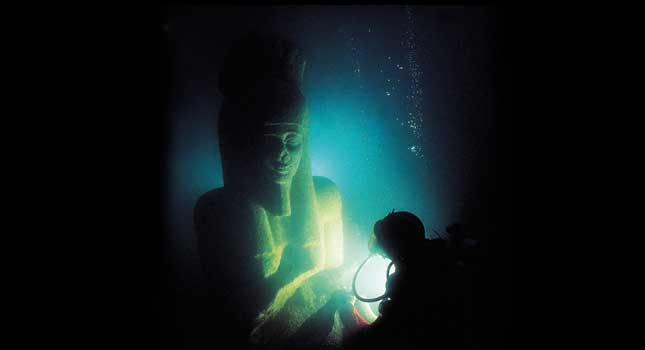
It’ll be opening on the 19th May 2016 with a long run as a major exhibition that will see it all the way through until the 27th November 2016. Organised with the Hilti Foundation and the Institut Européen d’Archéologie Sous-Marine, it will highlight the ancient relationship between the Egyptians and the Greeks, which face each other across the Mediterranean Sea.
Lying at the mouth of the River Nile, the two cities have been submerged under the sea since they sank in the 3rd or 2nd century CE (Common Era, the new, less theologically challenged equivalent to AD). They hadn’t been discovered since then until French underwater archaeologist, Franck Goddio, found them in 2000, while the rest of us were panicking about the millennium bug.
Having spent a large proportion of the intervening time studying the finds, we now have a good understanding of what they were like when they were thriving and bustling cities of the ancient world. Thonis-Heracleion, for example, was one of Egypt’s major cities for trade with the Mediterranean nations, while Canopus was the most significant port for Egypt’s trade with Greece before the foundation of Alexandria.
Luckily, the cities have been preserved pretty well under the relatively still waters of the Egyptian shoreline, so many objects, which will feature in the exhibition, have retained a lot of their original characteristics. This ranges from vast statues to incredible jewellery and shimmering Ptolemaic gold coins, as well as evidence of the importance of religion to the cities.
The exhibition will also include a variety of supporting objects from key Egyptian museums to set the context of the finds against what we know about the country during the time when Thonis-Heracleion and Canopus flourished. The British Museum has also got a pretty significant collection of objects of their own to add into the Sunken Cities Egypt’s Lost Worlds exhibition, so it should cover a lot of ground.
It will present new evidence of a society that worshiped Khonsou, son of Amun, among other deities, with a temple dedicated to him at Thonis-Heracleion. However, Egyptian religion was fairly complex and there’s also evidence of offerings and rituals for Osiris, the god of the underworld, which had a lot of influence due to his promise of eternal life.
You’ll also find out more about the political makeup of Egypt along with the importance of trade across the Mediterranean sea and the kings that controlled it all. It will take us through centuries of ancient history, featuring big historical names like Alexander the Great, Cleopatra and Hadrian, while also shedding light on the movement of people during that time to create a fascinating picture of life in the region.
Tickets for the Sunken Cities Egypt’s Lost Worlds exhibition are already available from The British Museum and cost £16.50 for adults with free entry for under 16s.


